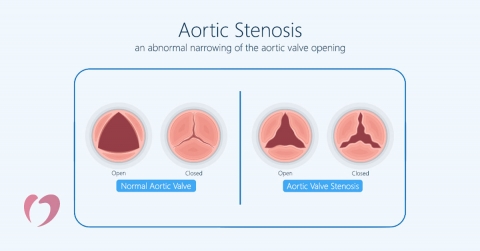Stenosis of the Heart Valves

The heart has four valves that each consist of three flaps that open and close to allow the correct amount of blood to flow into and out of the chambers of the heart. Stenosis is a specific type of heart valve disease that involves any one of the four valves being restricted and not allowing enough blood to flow through it. This constriction can happen because the valves narrow, thicken, or stiffen.
While many instances of stenosis involve three narrowed or thickened valves, sometimes valve flaps fuse together and create two flaps rather than three. Other times, a patient can be born with two flaps. These situations are called bicuspid valves.
Symptoms of stenosis vary with the severity and type of stenosis. Some types affect the flow of blood to the lungs, which can lead to shortness of breath and other breathing issues. Others create palpitations, fatigue, swelling in the extremities, and chest discomfort. When left untreated, the pressure from extra blood in the heart can lead to an enlarged heart, reduced oxygen levels, and eventually heart failure. The mildest stenosis has little to no symptoms.
What are the causes and risk factors of stenosis?
There are several causes of stenosis, depending on the specific type. As with many heart conditions, it is more common in older age. Some stenosis is congenital (present from birth), as is the case when a person is born with two valves and with pulmonary stenosis, which is a narrowing at the pulmonary valve.
Stenosis can also be caused by infection or other health problems like rheumatic fever, lupus, and infective endocarditis. In rare cases, stenosis can be caused by tumors or cancer treatment.
How is stenosis treated?
Valve stenosis can be successfully treated in most cases. Your doctor may recommend several courses of action, depending on the cause of the stenosis, the specific type, and the severity.
The mildest stenosis may not impair heart function much at all and will simply require regular monitoring. Other types are treated with regular monitoring plus medication to improve heart function. Medication cannot fix a constricted valve, but it can help to lessen the effects on the heart. Following the treatment recommended by your doctor is important, as some stenosis can have a large impact on your health.
When stenosis is severe enough, it requires repair or replacement of the valve. Some valve repairs can be done with minor surgery while others require more extensive surgery. Some valve replacements can be done using transcatheter aortic valve replacement (TAVR), a minimally invasive procedure, while others require open heart surgery.
If you have been diagnosed with stenosis or are having heart-related symptoms, Oklahoma Heart Hospital is here to help. Schedule an appointment with one of our specialists today.




